Scotland: Computing Science National 5, Highers and Advanced Highers
The size and shape of the secondary and primary sector[11]
| Primary (maintained) | Secondary (maintained) | |
|---|---|---|
| Schools | 2,005 | 357 |
| Students | 393,957 | 300,954 |
| Teachers | 25,651 | 24,077 |
There are around 50,000 students in each secondary school year band in Scotland.
The most recent student projections from the Scottish Government date from 2016 and indicate that primary numbers are stable and dropping from 2020, with a related slow rise in secondary numbers.
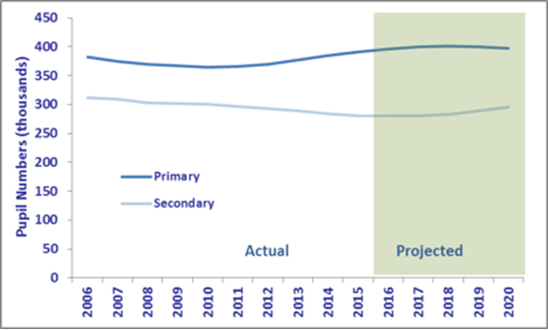
The current curriculum and assessment
This section attempts to capture in as summative a form as possible, the key characteristics of the main examinations currently available in Scotland, including the curriculum focus, assessment methodology and coding languages preferred.
Curriculum focus:
- Software design and development
- Computer systems
- Database design and development
- Web design and development
Assessment approach:
- Written examination and an assignment worth 50 out of 160 marks.
Language preferred:
- Any programming code that meets the course requirement (Python, Live Code, Visual Basic, True Basic, Java, Xojo (formerly real basic)) including SQA’s standardised reference language
Curriculum focus:
- Software design and development
- Computer systems
- Database design and development
- Web design and development
Assessment approach:
- Written examination and an assignment worth 50 out of 160 marks.
Language preferred:
- Any programming code that meets the course requirement (Python, Live Code, Visual Basic, True Basic, Java, Xojo (formerly real basic)) including SQA’s standardised reference language
Curriculum focus:
- Software design and development
- Computer systems
- Database design and development
- Web design and development
Assessment approach:
- Written examination and an assignment worth 80 out of 160 marks.
Language preferred:
- Any programming code (Python, Live Code, Visual Basic, Java) and SQA’s standardised reference language
The teaching workforce
There are currently at least 595 teachers in Scottish secondary schools delivering Computing Science, little changed from the number in 2016 (594). Interestingly, in 2008, there were 766 Computing Studies teachers[46] indicating a 22% decline in teaching capacity in just over a decade, across a period when student numbers were relatively stable.
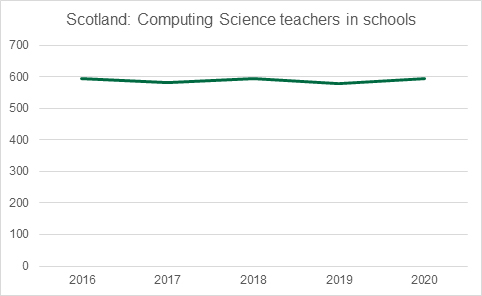
Recruitment to initial teacher education/training for Computing Science (as with many STEM subjects) remains a challenge in Scotland and is concentrated in four of the 11 initial teacher education / training providers. Over two thirds of the places are in two providers in Glasgow, which although the central belt is home to approximately 70% of the Scottish population, this regional consolidation may limit supply for the rest of the country.
To address the need for teachers, there are now bursaries in place to encourage recruitment[8], in 2021/22 the aim is to recruit 47 new entrants to the profession. This is still a difficult target to meet; at best, recruitment has only managed to get to a maximum 94% of the target in one year in the past five (from a low point of 68%) with the increased proximity to the target figure largely a result of it being steadily reduced.
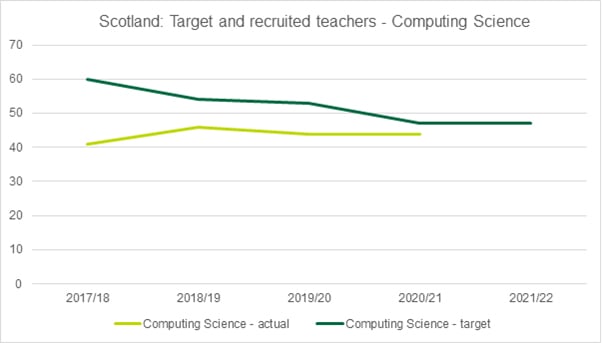
The General Teaching Council for Scotland encourages professional development for all teachers, teachers must demonstrate that they have updated their professional skills every five years[50]. They also only permit teachers to add additional subjects if they can demonstrate that they have the competence to teach a new subject at secondary level.
BCS, with funding from Microsoft, has supported The University of the Highlands and Islands (UHI) to develop an additional teaching qualification award in Computing Studies leading to BCS certification to support teachers wishing to add this subject to their portfolio[51].
A 2014 initiative to create a teacher professional learning network for Computer Science teachers (Professional Learning and Networking in Computing - PLAN C) produced promising outcomes such as engaging over 300 teachers, gaining positive feedback on their proposed pathways to change model and identifying lessons for future professional development[52].
Attainment and participation
The pattern of participation in Scotland shows a drop of over 20% participation at National 5 across five years (likely contributing factors may include staffing in schools, changes in course and assessment and the narrowing of subject choices in some schools), although the most recent data shows an upturn at all levels.
The SQA has also been offering a wider and more diverse range of employment-focused digital skills awards (such as National Progression Awards - NPA) which are beginning to be taken up in schools (in 2021, 634 students took an NPA in Computer Games development at Scottish Credit and Qualifications Framework (SCQF) level 5).
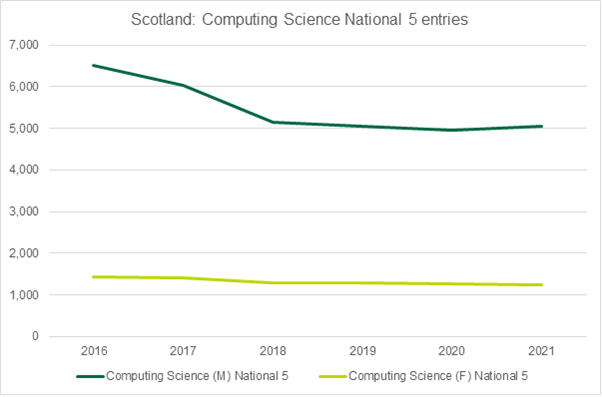
In 2015, schools could offer an old Computing Higher or a new Computing Science Higher. In this year, entries represent 1,182 students taking Computing Science plus 3,008 taking the original Computing Higher (with a male:female ratio of 6:1).
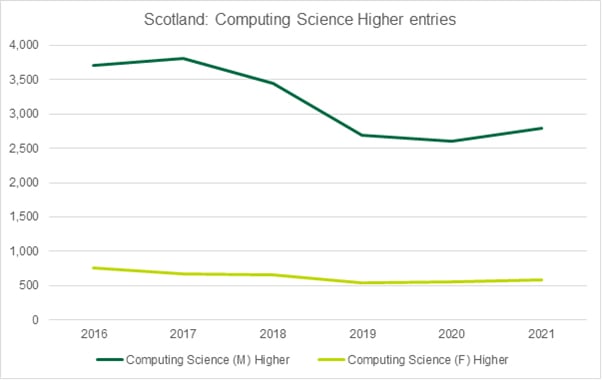
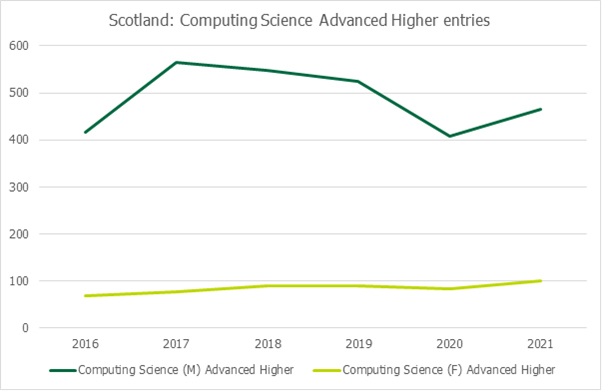
The following charts set out Computing Science attainment by male and female candidates over the past five years (cumulative percentages).
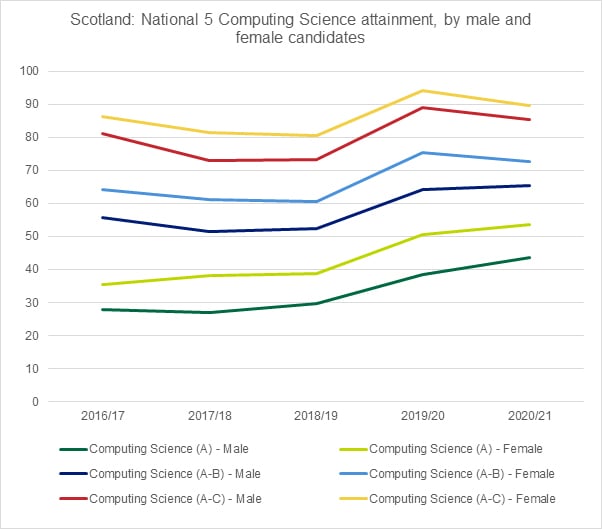
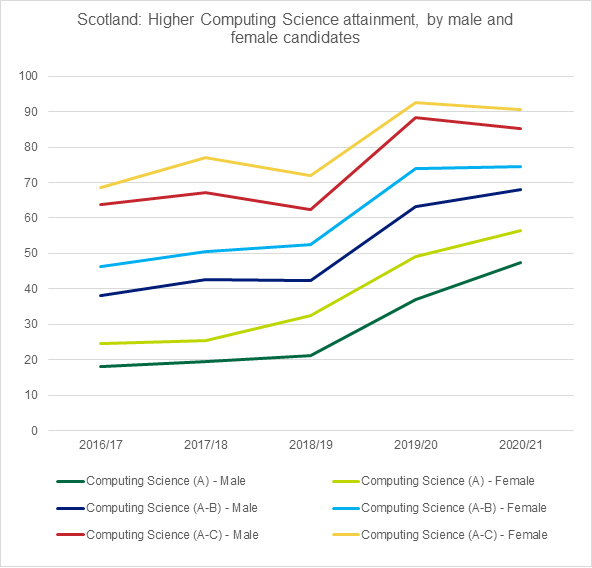
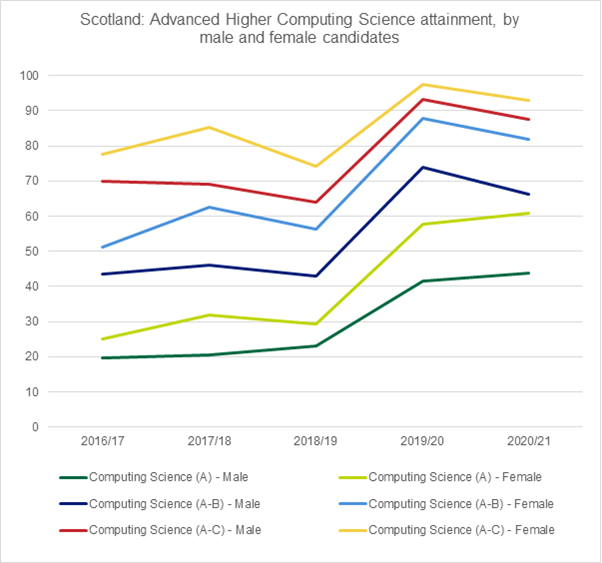
In common with England, at the higher grades, female candidates are regularly outperforming male candidates.
The participation patterns reflect those in other parts of the UK, with at most (National 5) 20% of entrants being female and at worst 12% (Advanced Higher). Total numbers of female participants in Computing Science qualifications have broadly held up, but they are notably out of step with male participation.
In Scotland, the 2020 data (latest year for which there are detailed cohort sizes) indicates that National 5 participation was 12% of the cohort, with 7% and 2% respectively taking the Higher and Advanced Higher options. These data have been consistent over five years, so it is unlikely that it will have been very different in 2021.
In 2021, National 5 Computing Science was the 15th most popular N5 award, by entries. It was the least popular science and physics (the next most popular science) attracted almost three-times as many entries.
Higher Computing Science was the 18th most popular Higher award, by entries. It was the least popular science and human biology (the next most popular science) attracted almost twice as many entries (physics, almost three-times).
Advance higher Computing Science was the 16th most popular Higher award, by entries. It was the least popular science and physics (the next most popular science) attracted over three-times as many entries.
There is currently no published data illustrating uptake by young people from different socioeconomic backgrounds, or by ethnicity.













